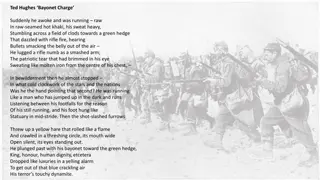Evolution of Soldier Recruitment and Training from 1700 to 1900
Soldier recruitment and training methods between 1700 and 1900 underwent significant changes, with men signing up for short enlistments or life service with incentives like steady pay and bounties. However, challenges such as poor quality soldiers, disciplinary issues, and desertions persisted. Other methods included the Militia Act of 1757 and the practice of colonels recruiting and training their regiments for profit.
Download Presentation

Please find below an Image/Link to download the presentation.
The content on the website is provided AS IS for your information and personal use only. It may not be sold, licensed, or shared on other websites without obtaining consent from the author. Download presentation by click this link. If you encounter any issues during the download, it is possible that the publisher has removed the file from their server.
E N D
Presentation Transcript
How much change was there in training and recruiting soldiers between 1700 and 1900?
Learning objective to be able to identify changes and continuities in Modern English recruitment and training. I can explain the key changes continuities Modern recruitment training. Grade 6 I can explain and assess changes continuities in Modern English recruitment and training. Grade 9 I can describe the key changes and continuities in Modern English recruitment and training. Grade 3 and in and English and
What was the condition of the army between 1700 and 1900? Despite the fact that Britain had a permanent, national army throughout this period, its size fluctuated dependent on need. For example, the army was larger during both the Napoleonic and Crimean Wars. The main reasons for the relatively small size of the British army were People were suspicious that a large army could be used against the people. The government saw the navy and not the army as the main source of defence. Large armies meant higher taxes.
What were the main methods of recruitment between 1700 and 1900? Men usually signed up for short enlistments [lasted 8-12 years] or for life [21 years]. Incentives for recruitment included Steady pay 8d a day. Bounties for signing up for life. Usually 3. Recruited in the taverns this was called crimping. During wartime, criminals were released if they agreed to sign up to the army.
What were the main problems in recruitment between 1700 and 1900? Generally, these recruitment methods raised poor quality soldiers. As a result, hard disciplinary measures were used to enforce discipline, such as flogging. Desertions were extremely common. It was particularly high during the Napoleonic Wars and many deserters had public sympathy.
What other methods of recruitment were there between 1700 and 1900? The Militia Act of 1757 This Act obliged every parish to make lists of men aged between 18-50 who could serve. Ballots were then drawn to choose men to serve for five years in the local militia. The militia were groups of men who had to defend the country if it was under invasion and could be used to boost numbers of the army in wartime. This replaced the Assize of Arms. Colonels regiments because expanding the army was unpopular and expensive, government paid large lump sums to a senior officer to recruit and train their own regiment. The officers would aim to train and recruit as cheaply as possible in order to make a profit.
Why were there problems in recruitment by 1850? Shortage of troops the British army was overstretched with its empire commitments and a poor number of troops were recruited to fight the Crimean War. Quality of troops the quality of officers and medical condition of the troops caused real concerns in the Crimean War. Failure of the 1858 Commission the government commission into the condition of the army came to nothing as its findings of mismanagement of supplies and poor recruitment were covered up.
Who caused the changes in recruitment after 1870? Gladstone the election of Gladstone in 1868 rang a need for change. Gladstone was determined to reform the army and enforce change by law. Edward Cardwell Cardwell was appointed as Minister for War by the new government. A fine administrator he was determined to make the army more professional despite opposition from the army itself.
What were Cardwells key reforms? Cardwell passed a series of laws introducing greater professionalism within the army. The 1870 Army Act changed the length of enlistment to 12 years 6 in the army and 6 in the reserves with annual retraining. Daily rate of pay was raised and after 12 years men could resign or sign up for another 12 years. This ensured a constant supply of trained men. 1871 Regularisation of the Forces Act reorganised regiments into regions with local barracks. All regiments had two linked battalions one serving abroad and one domestically. A third battalion would be the local militia. Other reforms included the abolition of the purchase system with promotion based on merit, improving rations, flogging and branding were abolished as punishments.
How limited were improvements in training between 1700 and 1800? A variety of methods were attempted to improve training. These were In 1708, the Duke of Marlborough issued a tactics manual for officers called New Exercises in Firelocks and Bayonets. It was widely ignored. Between 1728 and 1851 as series of regulations originally issued by George II were given to the whole army. These were often ignored. In 1741, the Royal Military Academy was established for gunners at Woolwich. The Napoleonic Wars saw changes in standard drills which were widely used by resisted by independently minded officers. Also, in 1800 the Royal Military College was established at Sandhurst to train officers. This was expanded to a second site at Camberley in 1857, doubling the capacity to train officers. Alongside this new military schools were opened to train weapons instructors one in Hythe in 1853 to train rifle instructors and the second in Shoeburyness in 1859 to train gunnery instructors.
Draw a continuum into your exercise books and place each change card on the continuum. The size of the army changed according to need. Desertions remained high. The Militia Act, 1757 obliged men to do military service when balloted. The 1871 Reorganisation of the Forces Act organised troops on local lines. Edward Cardwell appointed Minister for War and wanted more military professionalism Military schools were opened at Hythe and Shoeburyness to train weapons instructors. Quality of troops remained variable in terms of health and skills The Purchase System was abolished. Promotion was now based on merit In 1741, the Royal Military Academy was established at Woolwich. The 1870 Army Act streamlined enlistment. Flogging and branding were abolished as military punishments. In 1800, the Royal Military College was established at Sandhurst.
Extension Complete the following links - Link 2 hexagons where the sides touch. Link 3 hexagons where the sides touch. Link 4 hexagons where the sides touch. Link 5 hexagons where the sides touch. - - -
Plenary My Brain Subheading My Brain Draw an outline of your brain. Fill your drawn brain with all the things you have learnt in this lesson. This can be in the form of key words, drawings, bullet points, lists anything you like so long as it summarises your learning and that others can understand it. http://www.download1.ch/wp-content/uploads/2013/03/Brain-Clip-Art-Vector-Download1.ch_-300x208.jpg http://www.illustrationsof.com/royalty-free-brain-clipart-illustration-1077577.jpg























